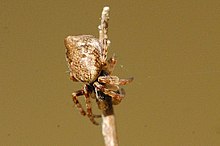
The genus Argiope includes rather large spiders that often have a strikingly coloured abdomen. These spiders are distributed throughout the world. Most countries in tropical or temperate climates host one or more species that are similar in appearance. The etymology of Argiope is from a Latin word argentum meaning silver. The carapace of Argiope species is typically covered in silvery hairs, and when crawling in the sun, they reflect it in a way that gives them a metallic, white appearance.

Uloboridae is a family of non-venomous spiders, known as cribellate orb weavers or hackled orb weavers. Their lack of venom glands is a secondarily evolved trait. Instead, they wrap their prey thoroughly in silk, cover it in regurgitated digestive enzymes, and then ingest the liquified body.

Orb-weaver spiders are members of the spider family Araneidae. They are the most common group of builders of spiral wheel-shaped webs often found in gardens, fields and forest. "Orb" can in English mean "circular", hence the English name of the group. Araneids have eight similar eyes, hairy or spiny legs, and no stridulating organs.
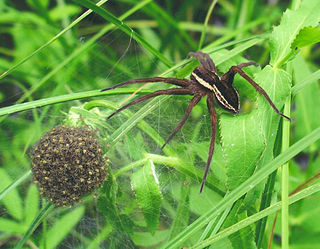
Dolomedes is a genus of large spiders of the family Pisauridae. They are also known as fishing spiders, raft spiders, dock spiders or wharf spiders. Almost all Dolomedes species are semiaquatic, with the exception of the tree-dwelling D. albineus of the southeastern United States. Many species have a striking pale stripe down each side of the body.

Nephila is a genus of araneomorph spiders noted for the impressive webs they weave. Nephila consists of numerous species found in warmer regions around the world. They are commonly called golden silk orb-weavers, golden orb-weavers, giant wood spiders, or banana spiders.
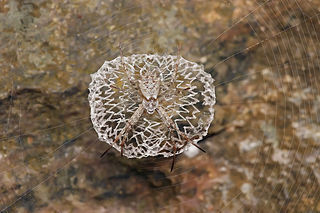
A web decoration or stabilimentum is a conspicuous silk structure included in the webs of some species of orb-web spider. Its function is a subject of debate.

The spider genus Steatoda, in the family Theridiidae, includes about 120 recognized species, distributed around the world. One common name is cupboard spider, for many species build their webs in dark, sheltered, undisturbed places around the house or garden, in sheds and garages, under garden furniture, compost bins, and the like. Signs of the cupboard spider include small white spots of spider droppings, like small splashes of paint, on the floor underneath the web.

Argiope keyserlingi is a species of orb-web spider found on the east coast of Australia, from central New South Wales to northern Queensland. It is very similar in appearance to a closely related North-Queensland species, Argiope aetherea. A. keyserlingi is commonly found in large populations in suburban parks and gardens, particularly among the leaves of the Lomandra longifolia. Like many species of orb-web spider, A. keyserlingi shows considerable sexual size dimorphism, as the females are many times larger than the males. Mature females can be seen during the summer months and it is not uncommon to see multiple males on the web of one female.

Argiope bruennichi is a species of orb-web spider distributed throughout central Europe, northern Europe, north Africa, parts of Asia, and the Azores archipelago. Like many other members of the genus Argiope, it shows striking yellow and black markings on its abdomen.

The spider species Argiope aurantia is commonly known as the yellow garden spider, black and yellow garden spider, golden garden spider, writing spider, zigzag spider, zipper spider, corn spider, Steeler spider, or McKinley spider. The species was first described by Hippolyte Lucas in 1833. It is common to the contiguous United States, Hawaii, southern Canada, Mexico, and Central America. It has distinctive yellow and black markings on the abdomen and a mostly white cephalothorax. Its scientific Latin name translates to "gilded silver-face". Males range from 5–9 mm (0.20–0.35 in); females range from 19–28 mm (0.75–1.10 in). These spiders may bite if disturbed or harassed, but the venom is harmless to non-allergic humans, roughly equivalent to a bumblebee sting in intensity.

Cyclosa, also called trashline orbweavers, is a genus of orb-weaver spiders first described by Anton Menge in 1866. Widely distributed worldwide, spiders of the genus Cyclosa build relatively small orb webs with a web decoration. The web decoration in Cyclosa spiders is often linear and includes prey remains and other debris, which probably serve to camouflage the spider. The name "Cyclosa" comes from Greek 'to move in a circle', referring to how it spins its web.
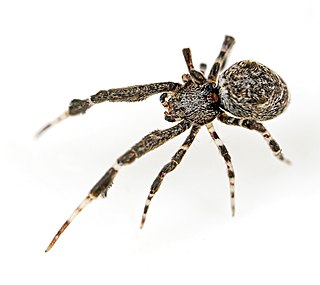
Uloborus plumipes is a species of Old World cribellate spider in the family Uloboridae. Common names include the feather-legged lace weaver and the garden centre spider, the latter name being due to its frequent occurrence of this spider in garden centres on the world. The species name is derived from the Latin pluma "feather" and pes "foot".

Gasteracantha fornicata is a species of spiny orb-weavers found in Queensland Australia. It is similar in shape to Austracantha minax which was originally described as Gasteracantha minax. It was described by Johan Christian Fabricius in 1775, the first Australian species of spider to be named and classified.

Argiope pulchella is a species of the orb-weaver spider family, Araneidae. It ranges from India to China and can be found on Java. It is a synanthropic species, often living in habitats associated with humans.
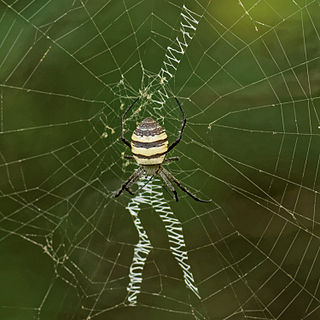
Argiope aemula, commonly known as the oval St Andrew's cross spider, is a species of spider in the family Araneidae which is native to southeast Asia, ranging from India and Sri Lanka to the Philippines, Indonesia, and Vanuatu. It is one of the giant, conspicuous "signature spider" species of the genus Argiope, observed in tropical and subtropical grasslands.

Cyclosa argenteoalba, in the trashline orbweavers genus, is a species of orb weaver in the spider family Araneidae. It is found in East Asia in the countries of China, Japan, and Korea. C. argenteoalba are diurnal, which means they are active during the day. Each individual has a unique appearance due to their differences in the ratio of black to silver coloring on their abdomen. Spiders with less silver coloring are better at catching prey, since the silver is bright and warns their prey. They catch their prey by waiting in the hub of their web until their prey is close enough to catch. Parasitic larvae are often found attached to C. argenteoalba, and the larvae are able to manipulate the spider's behavior. Females are on average 2 mm longer in size than males. During mating, female genital mutilation is common in order to increase the fitness of the male. On their webs, they often attach silk “decorations” that are thought to deter predators. Relocating to a different place to build a new web occurs frequently until they find a location with a significant amount of prey.
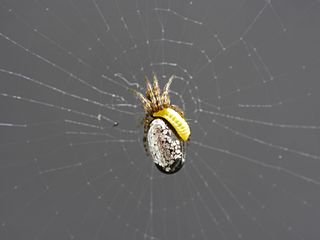
Reclinervellus nielseni is one of the spider-ectoparasitoids belonging to the Polysphincta genus-group and utilizes exclusively Cyclosa spiders as hosts. The species is distributed through Canada region but is rather sparse. Host spider species is different in accordance with the region, that is Cyclosa conica in Europe whereas Cyclosa argenteoalba in Japan.

Cyclosa turbinata is a species of orb weaver in the family of spiders known as Araneidae. It is found in a range from the United States to Panama, West Indies, Galapagos Islands, and has been introduced into Hawaii.

Argiope versicolor, the multi-coloured Saint Andrew's cross spider, is a species of orb-weaver spider found mostly in Southeast Asia, from China to Indonesia (Java).
Latrodectus revivensis, also known as the desert widow, is a species of venomous spider belonging to the Latrodectus genus and located in the Negev desert and the Arava valley (Arabah).
